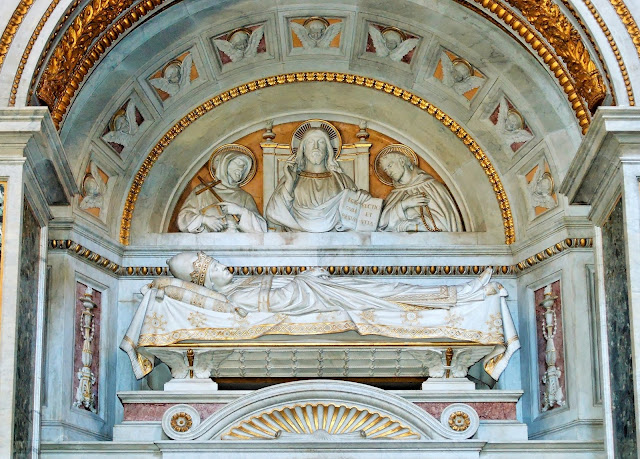Pope Innocent III Burial Monument
Pope Innocent III Burial Monument in St. John Lateran Basilica. On top, a bas relief with three figures: Jesus and Saints Francis and Dominic. This 19th-century tomb was designed by Giuseppe Lucchetti and presents a high prostrated effigy of the Pope.
Innocent III was not an unoccupied Pope. He was arbitrator in the dispute for the succession to the throne of Germany, was engaged in angry disputes with John of England that resulted in the questioning of the entire country, promoted the fourth Crusade and strongly opposed excesses committed by the Crusaders, reaching excommunicate them. He also reorganized the papal curia, promoted the crusade against the Albigenses and celebrated the twelfth Ecumenical Council of Lateran, in which his heresies were condemned, along with the Waldenses and those of Joaquin de Fiore. And all this in a time where the Church suffered a lot from serious internal inconsistencies: political conflicts, excessive bureaucracy, suffocating bureaucratic apparatus.
In this context, very hard for the Church, Francis must have had great confidence in Divine Providence to wait to be received by the powerful Innocent III. Some historians say that the Pope did not receive him on his first attempt. Others, who are many, say that Innocent agreed to find them due to a dream in which he saw Francisco supporting with his shoulders one of the columns of the Basilica of St. John Lateran. And there are other stories about it, but the fact is that he received it and this is, in itself, the first great miracle of this meeting.
On the other hand, the same proliferation of Manichaean heresies, which radically opposed the flesh to the spirit, were but an undesirable fruit of the poor testimony of holiness that Christians gave and of the internal crisis that the Church was going through. If we wanted to think badly, we could say that Francisco's poverty and his sincere effort to live the Gospel radically placed him morally well above the concerns that by the year 1210 interested the Church. It would have been very easy for the poor of Assisi to continue their works and their preaching, dispensing with the authorization of a Pope who had little time for the grazing of souls and the instruction of godly enterprises.
However, Francisco never gave in to this way of thinking. Even without needing the approval of his constitutions to continue his work of evangelization, he decided to go to Rome with the certainty that the blessing of the Church by the Pope was the indispensable sign that would allow him to know that his work came from God and not from the men. But what a great son of the Church is Francis! The poor of Assisi knew how to transcend the human sins that stained the outside of the Church and knew how to recognize in the midst of all that dirt accumulated to the Mother, to the source of Grace, to the Universal Sacrament of Salvation that can only come from the Holy Spirit.
This image is a public domain image, which means either that copyright has expired in the image or the copyright holder has waived their copyright. Franciscan Gallery charges for the access to high resolution copy of the image. Manually restoration was necessary in order to improve quality, without covering the original image.






Comments
Post a Comment